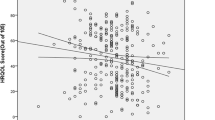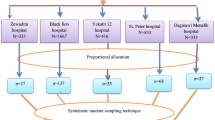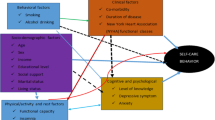Abstract
Given the prevalence of Heart Failure (HF), the current study was conducted, aiming to determine the relationship between praying and self-care in the patients with HF in Iran in 2018. The type of the study is descriptive-analytical, which has been conducted in patient group of more than 65, suffering HF. The population of study has consisted of HF patients, referring to Shahid Mostafa Khomeini Hospital of Ilam province. Therefore, the patients, referring to this hospital for medical treatments, were included in this study. The study data were analyzed using software SPSS16. The findings showed there was a significant relationship between the severity of prayer and the demographic variables, such as gender (p < 0.004), education (p < 0.03), and duration of the disease (p < 0.001). The findings also showed that there was a relationship between self-care and gender (p < 0.001), education (p < 0.004), and duration of disease (p < 0.001). Also, the findings showed that there is a relationship between self-care and prayer (r = 727), so that increasing the amount of prayer will increase self-care. The mean (SD) of total prayer is 167.33 (10.49) and total self-care is 35.86 (10.60). With the increase in the rate of praying, their self-care increased. Based upon this, religious interventions are recommended to be held for this group of patients, focusing on praying.
Similar content being viewed by others
References
Al-Lamee, R., Thompson, D., Dehbi, H.-M., Sen, S., Tang, K., Davies, J., et al. (2018). Percutaneous coronary intervention in stable angina (ORBITA): A double-blind, randomised controlled trial. The Lancet,391, 31–40.
Ambrosy, A. P., Cerbin, L. P., Devore, A. D., Greene, S. J., Kraus, W. E., O’connor, C. M., et al. (2017). Aerobic exercise training and general health status in ambulatory heart failure patients with a reduced ejection fraction—findings from the Heart Failure and A Controlled Trial Investigating Outcomes of Exercise Training (HF-ACTION) trial. American Heart Journal,186, 130–138.
Amraei, M., Ghorbani, A., Seifinejad, Y., Mousavi, S. F., Mohamadpour, M., & Shirzadpour, E. (2018). The effect of hydroalcoholic extract of Teucrium polium L. on the inflammatory markers and lipid profile in hypercholesterolemic rats. Journal of Inflammation Research,11, 265.
Annema, C., Luttik, M.-L., & Jaarsma, T. (2009). Reasons for readmission in heart failure: perspectives of patients, caregivers, cardiologists, and heart failure nurses. Heart and Lung: The Journal of Acute and Critical Care,38, 427–434.
Asadzandi, M., Taghizade Karati, K., Tadrisi, S., & Abbas, E. (2011). Effect of prayer on severity of patients illness in intensive care units. Iranian Journal of Critical Care Nursing,4, 1–6.
Bahrem, M., Alikhani, M., Jalali, A., Mahboubi, M., & Farnia, V. (2017). Mental health of patients with heart disease: Analysis of alexithymia and family social support. Biomedical Research (Special Issue: S8–S12), 8–12.
Behdani, S., Dastjerdi, R., & Sharifzadeh, G. R. (2012). Relationship between trust in God and self–efficacy with mental health in type II diabetics. Journal of Birjand University of Medical Sciences,19, 302–311.
Capilouto, S., Brewer, E. M., & Crawford, W. (2018). Implementing a protocol to improve self-care behaviors in adult patients with heart failure. Journal of Doctoral Nursing Practice,11, 59–71.
Celano, C. M., Villegas, A. C., Albanese, A. M., Gaggin, H. K., & Huffman, J. C. (2018). Depression and anxiety in heart failure: A review. Harvard Review of Psychiatry,26, 175–184.
Chen, D.-M., Yu, W.-C., Hung, H.-F., Tsai, J.-C., Wu, H.-Y., & Chiou, A.-F. (2018). The effects of Baduanjin exercise on fatigue and quality of life in patients with heart failure: A randomized controlled trial. European Journal of Cardiovascular Nursing,17, 456–466.
Chew, H. S. J., Cheng, H. Y., & Chair, S. Y. (2019). The suitability of motivational interviewing versus cognitive behavioural interventions on improving self-care in patients with heart failure: A literature review and discussion paper. Applied Nursing Research,45, 17–22.
Danielsen, R., Thorgeirsson, G., Einarsson, H., Ólafsson, Ö., Aspelund, T., Harris, T. B., et al. (2017). Prevalence of heart failure in the elderly and future projections: The AGES-Reykjavík study. Scandinavian Cardiovascular Journal,51, 183–189.
Dilmaghani, M. (2018). Importance of religion or spirituality and mental health in Canada. Journal of Religion and Health,57, 120–135.
Edelmann, F., Knosalla, C., Mörike, K., Muth, C., Prien, P., Störk, S., et al. (2018). Chronic heart failure. Deutsches Ärzteblatt International,115, 124.
Graven, L., Gordon, G., Keltner, J. G., Abbott, L., & Bahorski, J. (2018). Efficacy of a social support and problem-solving intervention on heart failure self-care: A pilot study. Patient Education and Counseling,101, 266–275.
Gregory, M. R. B., Prouhet, P. M., Russell, C. L., & Pfannenstiel, B. R. (2018). Quality of life for parents of children with congenital heart defect: A systematic review. Journal of Cardiovascular Nursing,33, 363–371.
Hasanpour-Dehkordi, A., Khodadadi, K., Khaledifar, A., & Salehi, S. (2015). The effect of recommended recitals on the severity of perceived pain in hospitalized patients undergoing surgery: A randomized clinical trial. Journal of Shahrekord Uuniversity of Medical Sciences, 16(6), 111–118.
Hassanpour-Dehkordi, A., & Jalali, A. (2016). Effect of progressive muscle relaxation on the fatigue and quality of life among Iranian aging persons. Acta Medica Iranica,54, 430–436.
Hojjati, H., Qorbani, M., Nazari, R., Sharifnia, H., & Akhundzadeh, G. (2010). On the relationship between prayer frequency and spiritual health in patients under hemodialysis-therapy. Journal of Fundamentals of Mental Health,12, 46.
Ilali, E., Taraghi, Z., Yazdani, J., Golmohammadi, M., Savasari, R., & Mosavi Jarrahi, A. (2016). The relationship between praying and spiritual health among Iranian older people with cerebrovascular accidents. Iranian Journal of Ageing,11, 424–431.
Jafari, Y., Rahimi, J., Bknazar, S., Lashkardoost, H., Mohaddes Hakkak, H. R., Mousavi Jajarmi, S. M., et al. (2015). The relationship between religious orientation and self-care practice in patients with type 2 diabetes. Journal of North Khorasan University of Medical Sciences, 7(2), 453–463.
Kalantari, F., Mehrabian, T., Savadkuhi, S., & Mosalman, M. (2015). An investigation of the relationship between the dimensions of prayer and spiritual health among patients under dialysis in Ilam, Iran. Religion and Health,3, 32–38.
Karimi, S., Makhsosi, B. R., Seyedi-Andi, S. J., Behzadi, M., Moghofeh, Y., Mohammadinasrabadi, K., et al. (2017). Surveying the effect of a self-care education program on severity of nausea and emesis in colorectal cancer patients under chemotherapy. Journal of Multidisciplinary Healthcare,10, 301–307.
Kemp, C. D., & Conte, J. V. (2012). The pathophysiology of heart failure. Cardiovascular Pathology,21, 365–371.
Khoshab, H., Nouhi, E., Tirgari, B., & Ahmadi, F. (2018a). Invisible cobwebs in teamwork—Impediments to the care of patients with heart failure: A qualitative study. The International Journal of Health Planning and Management, 33(2), e663–e673. https://doi.org/10.1002/hpm.2518.
Khoshab, H., Nouhi, E., Tirgari, B., & Ahmadi, F. (2018b). A survey on teamwork status in caring for patients with heart failure: A cross-sectional study. Journal of Interprofessional Care. https://doi.org/10.1080/13561820.2018.1512959.
Kievit, R. F., Gohar, A., Hoes, A. W., Bots, M. L., van Riet, E. E., van Mourik, Y., et al. (2018). Efficient selective screening for heart failure in elderly men and women from the community: A diagnostic individual participant data meta-analysis. European Journal of Preventive Cardiology,25, 437–446.
Lee, C. S., Lyons, K. S., Gelow, J. M., Mudd, J. O., Hiatt, S. O., Nguyen, T., et al. (2013). Validity and reliability of the European Heart Failure Self-care Behavior Scale among adults from the United States with symptomatic heart failure. European Journal of Cardiovascular Nursing,12, 214–218.
Mangolian Shahrbabaki, P., Nouhi, E., Kazemi, M., & Ahmadi, F. (2017). The sliding context of health: the challenges faced by patients with heart failure from the perspective of patients, healthcare providers and family members. Journal of Clinical Nursing,26, 3597–3609.
Mansouri, K., Hasavari, F., & Sedghi Sabet, M. (2018). Self-care status and it’s related factors in patients with heart failure. Journal of Health and Care,19, 232–241.
Mehrpoya, A., Jalali, R., Jalali, A., & Namdari, M. (2018). Patient experiences of living with coronary stent. Journal of Vascular Nursing,36(4), 181–185. https://doi.org/10.1016/j.jvn.2018.07.002.
Milan, M., Nasimi, F., Hafizi, I., Ghorbanzadeh, M., & Hosseini, Y. (2018). Association of spiritual health and quality of life in the hemodialysis patients admitted in Shahid Motahari Hospital in Jahrom, Iran (2016). Iran Journal of Nursing,31, 42–51.
Moazeni, Z., Miri, M., Sharifzadeh, G., & Behdani, S. (2014). The relationship between self-efficacy, trust in God, and anxiety in mothers of hospitalized children in Valiasr Hospital of Birjand. Modern Care Journal,11, 211–217.
Mohamed, C. R., Nelson, K., Wood, P., & Moss, C. (2015). Issues post-stroke for Muslim people in maintaining the practice of salat (prayer): A qualitative study. Collegian,22, 243–249.
Mohammadi, E., Khoshab, H., & Kazemnejad, A. (2016). Activities of daily living for patients with chronic heart failure: a partnership care model evaluation. Applied Nursing Research,30, 261–267.
Momeni, M., Khoshtarash, M., Ghanbari Khanghah, A., Salehzadeh, A., & Rahmatpour, P. (2013). Self-care behaviors and related factors in patients with heart failure reffering to medical and educational center of heart in Rasht. Journal of Holistic Nursing And Midwifery,23, 22–29.
Mozaffarian, D., Benjamin, E. J., Go, A. S., Arnett, D. K., Blaha, M. J., Cushman, M., et al. (2015). Heart disease and stroke statistics—2016 update: a report from the American Heart Association. Circulation, CIR. 0000000000000350.
Naimi, E., Eilami, O., Babuei, A., Rezaei, K., & Moslemirad, M. (2018). The effect of religious intervention using prayer for quality of life and psychological status of patients with permanent pacemaker. Journal of Religion and Health. https://doi.org/10.1007/s10943-018-0698-8.
Naseri-Salahshour, V., Varaei, S., Sajadi, M., Tajdari, S., Sabzaligol, M., & Fayazi, N. (2018). The effect of religious intervention on the level of consciousness of comatose patients hospitalized in an intensive care unit: a randomized clinical trial. European Journal of Integrative Medicine,21, 53–57.
Navidian, A., Mobaraki, H., & Shakiba, M. (2017). The effect of education through motivational interviewing compared with conventional education on self-care behaviors in heart failure patients with depression. Patient Education and Counseling,100, 1499–1504.
Norozi, S., Rai, A., Salimi, E., & Tavan, H. (2018). The incidence of major cardiovascular events relied coronary vessels after angioplasty and stent types complications. Tehran University Medical Journal,75, 722–729.
Pour, N. H., & Hojjati, H. (2015). The relationship between praying and life expectancy in cancerous patients. Journal of Medicine and Life,8, 60.
Pramesona, B. A., & Taneepanichskul, S. (2018). The effect of religious intervention on depressive symptoms and quality of life among Indonesian elderly in nursing homes: A quasi-experimental study. Clinical Interventions in Aging,13, 473.
Rezaei, M., Adib-Hajbaghery, M., Seyedfatemi, N., & Hoseini, F. (2008). Prayer in Iranian cancer patients undergoing chemotherapy. Complementary Therapies in Clinical Practice,14, 90–97.
Sajadi, M., Niazi, N., Khosravi, S., Yaghobi, A., Rezaei, M., & Koenig, H. G. (2018). Effect of spiritual counseling on spiritual well-being in Iranian women with cancer: A randomized clinical trial. Complementary Therapies in Clinical Practice,30, 79–84.
Salehzadeh, A., & Rahmatpour, P. (2013). Self-care behaviors and related factors in patients with heart failure reffering to medical and educational center of heart in Rasht. Journal of Holistic Nursing And Midwifery,23, 22–29.
Sedlar, N., Lainscak, M., Mårtensson, J., Strömberg, A., Jaarsma, T., & Farkas, J. (2017). Factors related to self-care behaviours in heart failure: a systematic review of European heart failure self-care behaviour scale studies. European Journal of Cardiovascular Nursing,16, 272–282.
Sepahvand, E., Jalai, R., Mirzaei, M., & Jahromi, M. K. (2015). Association between short sleep and body mass index, hypertension among acute coronary syndrome patients in coronary care unit. Global Journal of Health Science,7, 134.
Sethares, K. A., Flimlin, H. E., & Elliott, K. M. (2014). Perceived benefits and barriers of heart failure self-care during and after hospitalization. Home Healthcare Now,32, 482–488.
Shahrbabaki, P. M., Farokhzadian, J., & Hasanabadi, Z. (2012). Effect of self-care education on patient’s knowledge and performance with heart failure. Procedia-Social and Behavioral Sciences,31, 918–922.
Shahrbabaki, P. M., Nouhi, E., Kazemi, M., & Ahmadi, F. (2016). Defective support network: a major obstacle to coping for patients with heart failure: A qualitative study. Global Health Action,9, 30767.
Siavoshi, M., Darrudi, M., Novruzieh, S., Jamali Nik, M., & Bordbar, R. (2018). Effects of prayer on the spiritual health of patients with chronic heart failure. Religion and Health, 6(1, Spring & Summer), 29–36. (in Persian).
Syed Fatemi, N., Rezaei, M., Givari, A., & Hosseini, F. (2006). Prayer and spiritual well-being in cancer patients. Payesh, 5(4), 295–303.
Waldron, N. H., Haney, J. C., Suarez, A., & Swaminathan, M. (2018). The value of echocardiography in unexpected valve disease in a patient with ischemic cardiomyopathy: Less is not always the right answer. Journal of Cardiothoracic and Vascular Anesthesia,32, 389–392.
Zilberszac, R., Heinze, G., Binder, T., Laufer, G., Gabriel, H., & Rosenhek, R. (2018). Long-term outcome of active surveillance in severe but asymptomatic primary mitral regurgitation. JACC Cardiovascular Imaging,11, 1213–1221.
Funding
Student Research Committee, Kermanshah University of Medical Sciences, Kermanshah, Iran (Grant Number: 3007281)
Author information
Authors and Affiliations
Corresponding author
Ethics declarations
Conflict of interest
The authors declare that they have no conflict of interest.
Research Involving Human Participants and/or Animals
No applicable.
Informed Consent
Assign the patients randomly in the spiritual intervention group and control group. All procedures performed in studies involving human participants were in accordance with the ethical standards of the institutional and/or national research committee and with the 1964 Declaration of Helsinki and its later amendments or comparable ethical standards.
Additional information
Publisher's Note
Springer Nature remains neutral with regard to jurisdictional claims in published maps and institutional affiliations.
Rights and permissions
About this article
Cite this article
Kazeminezhad, B., Tarjoman, A. & Borji, M. Relationship Between Praying and Self-Care in Elderly with Heart Failure: A Cross-Sectional Study in West of Iran. J Relig Health 59, 19–28 (2020). https://doi.org/10.1007/s10943-018-00757-8
Published:
Issue Date:
DOI: https://doi.org/10.1007/s10943-018-00757-8




